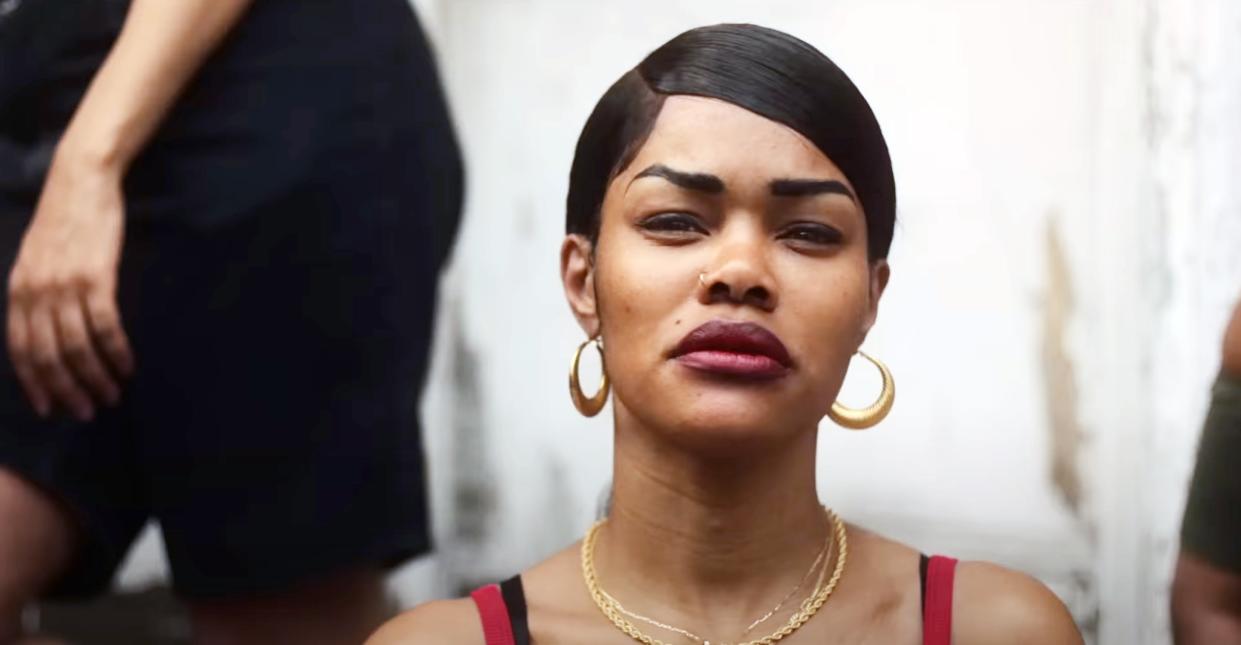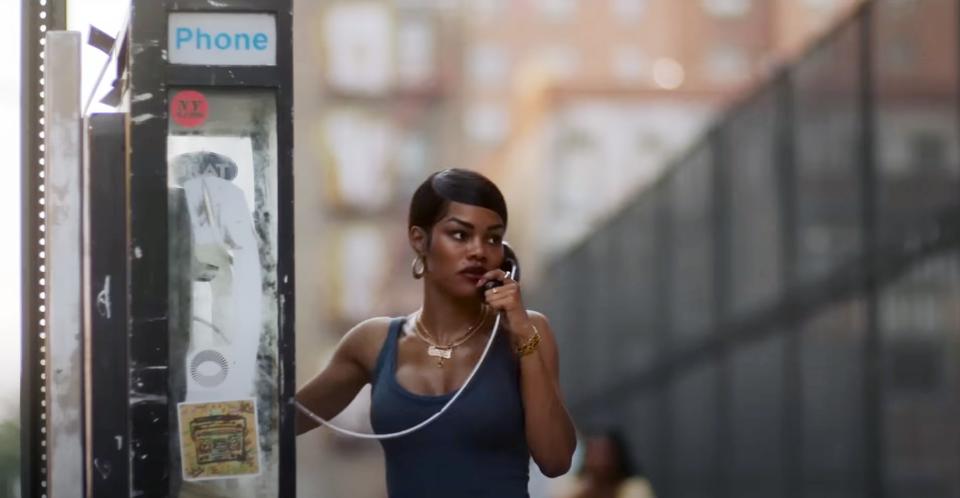Teyana Taylor Felt Her Remarkable Role in ‘A Thousand and One’ Was Written Just for Her

- Oops!Something went wrong.Please try again later.
Like many listeners of her music, soulful contemporary R&B ballads with a romantic lyricism, Teyana Taylor is feeling blessed. A sultry-voiced singer and songwriter who once choreographed for Beyoncé, Taylor proved herself a true impresario with a searing debut performance in A.V. Rockwell’s Sundance winner “A Thousand and One.”
In the impressive debut feature, Taylor plays a single mother named Inez who stops at nothing to keep her young son in her custody. Set over the course of 15 years in Harlem, Taylor shows remarkable range, charisma, and restraint throughout the film’s sweeping narrative.
More from IndieWire
'Dungeons & Dragons: Honor Among Thieves' Brings Honor to the Box Office
How 'Rye Lane' Filmmaker Raine Allen-Miller Snagged That Rom-Com King for a 'Spicy' Cameo
Though she’s appeared onscreen before, it was usually in dance films like “Honey” or reality shows “The Masked Singer.” With her luminous turn as Inez, Taylor firmly announces herself as a major dramatic acting talent. A cunning performer and major musical talent, while Taylor found massive success as a recording artist, she always nursed dreams of acting.
After the spring release of “A Thousand and One,” she’ll next appear in the Kenya Barris-penned remake of “White Men Can’t Jump” and the Jay-Z-produced biblical epic “The Book of Clarence,” in which she plays Mary Magdalene.
For Taylor, it’s “all [her] prayers being answered.”
The following interview has been edited and condensed for clarity.
IndieWire: You’re primarily known as a singer, did you always want to act?
Teyana Taylor: I always wanted to be an actor, and music was just more so in the forefront. As you can see, I do everything. So I’m just finally in a space where I’m making sure I’m plugging in every single outlet, every single socket, that’s my goal.
And this role excited me because it’s something that I always wanted. I think a lot of the roles that I got before were based off of me being some type of artist in a sense. “Oh yeah, she dances really well, let’s do this role.” Or, “She has a hot body, so yeah, let’s let her be the da, da da.” But I’ve always prayed for a role like this that could really show my range and open people’s eyes to what I could really do, to do this for real.
What was the audition process like?
They were looking for different Inezes. This was a project that was very near and dear to [writer/director] A.V. [Rockwell]’s heart. So she wasn’t just rolling that easy. She wasn’t just going to pick anybody. She did a long, thorough search for Inez.
I remember it came across my desk from my agency, and it was the audition sides and just the synopsis and a little bit about Inez. It wasn’t even the whole script. And immediately, I clung onto it and I was like, “I want to do this.” I told my videographers to set it up. “I’m doing a read right now.” I literally only read it one time and sent it right in because this is what I had been waiting for.
I was like, “Wow, I definitely think it’s something that’s already written for me.” And at that point, I treated it as if it was mine to lose, rather than it just being a random audition.

©Focus Features/Courtesy Everett Collection
What was about those sides and synopsis that drew you to the project so immediately?
Just Inez’s story and her strength, and how much of a survivor she was. Of course, one of the biggest pluses was that she was from Harlem. I’m a Harlem girl, so that was dope. I see a lot of the women around me, I see a lot of Inez in them. I see even a lot of Inez within myself in different ways. So it was definitely something that I was ready to tap into.
What of yourself did you see in Inez specifically?
Her survival skills are just amazing. I feel like I’ve been a survivor just navigating my way through this industry, and it’s her mission of just like, she’s such a giver. And her obsession with giving love and just giving all of her. That’s so me, I’m such a giver and I’m just naturally a helper and always felt like that was my higher calling just to help others. And I think where I’ve seen a lot of myself in Inez is both of us trying to figure out, “OK, when do we have time to give that type of love to ourself?”
Were you familiar with A.V. Rockwell’s work before this project?
I knew it was going to be incredible and artistic. I had seen a few things that [Rockwell] had done. So even when I heard her name and heard that she was attached, I thought it was really dope.
I’m a director as well, so to know that it was her first feature film, I thought that that was super amazing because I’m like, I can definitely learn from that because I came from the video director world where I just did videos, but my work had always been narrative work. So it was also dope to be a student on set with an amazing director that was doing her first feature film, it was dope to learn from that and take notes.
What was one of the most challenging things about the role?
I think what the most difficult thing was was the changing of the maturity for Inez. Because we didn’t shoot in order. So one day I would have to be 22-year-old Inez, and then the next day I have to be 33 year-old-Inez. And having to tap into those different emotions, because if you’ve seen the movie from the beginning, you have this younger inner child, kind of free-spirited and loud. And then as she gets older, she starts to dial back a little bit and get a little bit more stressed out.
And then as she loses Lucky, she’s completely damn near tapped out. So I think having to balance the emotions and where Inez was in her life was the most difficult part of it is the going up and down, even in between my sons, dealing with the different layers of the Terrys that I had to deal with, with the different triggers, and then you have young, innocent Terry. It was a lot to balance.
How did you keep track of her emotional state while shooting out of sequence?
One thing that me and [Rockwell] did, which I feel like was very helpful, was we created a color palette. So by the time we got done workshopping, my script was like a rainbow script.
As an example, the color red for Inez meant that she was in an angry space, and maybe green was Inez in a vulnerable space, and then maybe pink was Inez in a happy space, and maybe blue was Inez’s inner child. So we created these different layers.
Are you done with music for now?
I think right now, it’s just not that much to the forefront as it used to be. Right now, I’m just happy where I am and I’m just locked in. And this was one of my main goals to really be able to tap in on other things that I really love. And I think we all go through that stage in life where we just want to try new things. Like I said, not keeping myself in one box or keeping myself plugged into one socket.
At this point, I’m like a Glade Plugin. My musical Glade Plugin, it’s still in a room and it still smells good. Now I’m in my acting acting and directing Glade Plugin, and I’m just working different rooms and working my different areas.
Focus Features will release “A Thousand and One” in select theaters on Friday, March 31.
Best of IndieWire
Guillermo del Toro's Favorite Movies: 52 Films the Director Wants You to See
New Movies: Release Calendar for March 31, Plus Where to Watch the Latest Films
Martin Scorsese's Favorite Movies: 58 Films the Director Wants You to See
Sign up for Indiewire's Newsletter. For the latest news, follow us on Facebook, Twitter, and Instagram.

